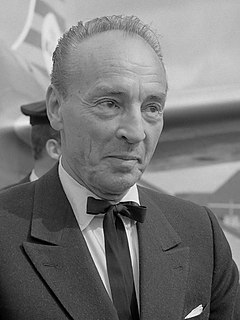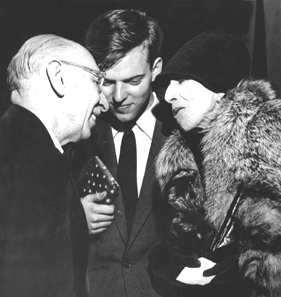Related Research Articles

Igor Fyodorovich Stravinsky was a Russian-born composer, pianist, and conductor. He is widely considered one of the most important and influential composers of the 20th century.

George Balanchine was an American ballet choreographer who was one of the most influential 20th-century choreographers. Styled as the father of American ballet, he co-founded the New York City Ballet and remained its Artistic Director for more than 35 years.

Robert Lawson Craft was an American conductor and writer. He is best known for his intimate professional relationship with Igor Stravinsky, on which Craft drew in producing numerous recordings and books.

New York City Ballet (NYCB) is a ballet company founded in 1948 by choreographer George Balanchine and Lincoln Kirstein. Balanchine and Jerome Robbins are considered the founding choreographers of the company. Léon Barzin was the company's first music director. City Ballet grew out of earlier troupes: the Producing Company of the School of American Ballet, 1934; the American Ballet, 1935, and Ballet Caravan, 1936, which merged into American Ballet Caravan, 1941; and directly from the Ballet Society, 1946.

Carlo Gesualdo da Venosa was Prince of Venosa and Count of Conza. As a composer he is known for writing intensely expressive madrigals and pieces of sacred music that use a chromatic language not heard again until the late 19th century. The best known fact of his life is his gruesome killing of his first wife and her aristocratic lover upon finding them in flagrante delicto. The fascination for his extraordinary music and for his shocking acts have gone hand in hand.
Giovanni de Macque was a Netherlandish composer of the late Renaissance and early Baroque, who spent almost his entire life in Italy. He was one of the most famous Neapolitan composers of the late 16th century; some of his experimentation with chromaticism was likely influenced by Carlo Gesualdo, who was an associate of his.

Philippe, Knight Herreweghe is a Belgian conductor.
The music of Basilicata is sparse at the moment. There is little theatrical or staged musical tradition, and the facilities have not yet fully recovered from the 1980 Irpinia earthquake. Yet, the area has some interesting things to offer musically.
Le Baiser de la fée is a ballet in one act and four scenes composed by Igor Stravinsky in 1928 and revised in 1950 for George Balanchine and the New York City Ballet. Based on Hans Christian Andersen's short story Isjomfruen, the work is an homage to Pyotr Ilyich Tchaikovsky, for the 35th anniversary of the composer's death. Stravinsky elaborated several melodies from early piano pieces and songs by Tchaikovsky in his score. A commission by Ida Rubinstein from 1927, the ballet was choreographed by Bronislava Nijinska and premiered in Paris on 27 November 1928.

John Reardon was an American baritone and actor who was noted for his performances on television, including many appearances on the PBS children's television show Mr. Rogers' Neighborhood. Making his debut with the New York City Opera in 1954, he sang thirty-three roles with them until 1972, returning in 1983 for performances as Danilo in The Merry Widow. Reardon was a member of the New York Metropolitan Opera from 1965 until 1977, appearing in such operas as Carmen and Jenufa. In 1967, Reardon created the role of Orin Mannon in the world premiere of Marvin David Levy's Mourning Becomes Electra. His last performance at the Met was as Papageno in The Magic Flute on April 6, 1977. He co-starred with Phil Silvers on Broadway in the Jule Styne musical Do Re Mi introducing the standard song "Make Someone Happy". He also appeared on Broadway in New Faces of 1956 and Gian Carlo Menotti's The Saint of Bleecker Street. He performed the role of Schaunard in the famous 1956 recording of La Boheme conducted by Sir Thomas Beecham. In 1960 he created a main role of Mr. McC in a nine-minute opera Introductions and Good-Byes by Lukas Foss, premiered on May 5, 1960 in New York City with New York Philharmonic conducted by Leonard Bernstein. In 1969 he created the role of Dr. Stone in the premiere of Menotti's Help, Help, the Globolinks! at the Santa Fe Opera. Reardon was chosen by Igor Stravinsky to sing the role of Nick Shadow on Stravinsky's second recording of his opera The Rake's Progress. Reardon also appears on several of Ben Bagley's Painted Smiles "Revisited" albums.
Glenn E. Watkins, is the Earl V. Moore Professor (Emeritus) of Music History and Musicology at the University of Michigan and a specialist in the study of Renaissance and 20th-century music.

Nicholas Magallanes was a principal dancer and charter member of the New York City Ballet. Along with Francisco Moncion, Maria Tallchief, and Tanaquil Le Clercq, Magallanes was among the core group of dancers with which George Balanchine and Lincoln Kirstein formed Ballet Society, the immediate predecessor of the New York City Ballet.
John Taras was a prominent American ballet master, repetiteur, and choreographer.
Élégie is a neoclassical ballet made by New York City Ballet's founding ballet master George Balanchine to Igor Stravinsky's Élégie for solo viola (1944). The first of three ballets made with this title was a pas de deux which had its première Monday, November 5, 1945, on a program of the National Orchestral Society entitled Adventure in Ballet, together with Circus Polka, danced by School of American Ballet students with Todd Bolender as guest artist, and Symphonie Concertante.
Ragtime (I) is the second of three ballets made by New York City Ballet's co-founder and balletmaster George Balanchine to Igor Stravinsky's 1918 Ragtime for Eleven Instruments; with scenery by Robert Drew previously used for Lew Christensen's 1947 work for Ballet Society, Blackface; costumes by Karinska and lighting by David Hays. The premiere took place on December 7, 1960, at City Center of Music and Drama, conducted by Robert Irving, as part of a quartet of works titled Jazz Concert, together with dances by Todd Bolender's Creation of the World, Francisco Moncion's Les biches and John Taras' Ebony Concerto. Balanchine's 1966 Ragtime (II) was also made for City Ballet; his previous ballet to Stravinsky's Ragtime was one of a number of "informal little things" made in St. Petersburg in 1922.
Monumentum pro Gesualdo is a ballet by the New York City Ballet (NYCB) co-founder and balletmaster George Balanchine to music by Igor Stravinsky composed in honor of the 400th birthday of the composer Carlo Gesualdo and consisting of Stravinsky's orchestrations of Gesualdo's madrigals. The premiere took place on Wednesday, November 16, 1960, at City Center of Music and Drama, New York, with scenery and lighting by David Hays and was conducted by Robert Irving. The composer conducted the score's orchestral premiere on Tuesday, September 27, 1960, for the XXIII Venice Music Festival at La Fenice.

The Double Canon is a short composition for string quartet by Igor Stravinsky, composed in 1959. It lasts only about a minute and a quarter in performance.
Danses concertantes is the title of more than a dozen ballets set to the score of the same title for chamber orchestra written in 1941–42 by Igor Stravinsky. Commissioned by Werner Janssen, it has been used for ballets by numerous choreographers attracted by its undeniable danceability.
Elaine Bonazzi was an American operatic mezzo-soprano who had an active international career from the 1950s through the 1990s. A singer with an unusually broad repertoire that encompassed both classical and contemporary works, she notably created roles in the world premieres of operas by composers Dominick Argento, David Carlson, Carlisle Floyd, Gian Carlo Menotti, Thomas Pasatieri, and Ned Rorem. In the United States she was particularly active with the New York City Opera, the Santa Fe Opera, and the Washington National Opera.
References
|
|